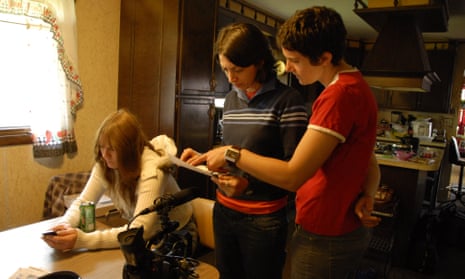Festive programming has traditionally pivoted around costume dramas and cartoons; a bittersweet story, a small death, a small life. Snow as a metaphor for either purity or devastation, or both. War, and also peace. But this year the perfect festive programme, the one that made me feel all those life-ish things you’re meant to feel at Christmas, was a 10-hour true-crime documentary about entrenched power structures, class, and the innate fallibility of the criminal justice system. Happy new year.
It starts at the end. In the first episode of Netflix’s Making a Murderer, we meet Steven Avery on his release after 18 years in prison for a violent sexual assault – DNA evidence has finally confirmed that he was innocent. Avery becomes a small-town celebrity. He is happy, and in love, and about to become rich. Except no, of course not. By the end of the first hour, as his $36m lawsuit begins against Manitowoc County, the dismembered body of photographer Teresa Halbach is found in the fire pit beside his trailer. Avery’s second trial begins, with all the weary inevitability of the opening scenes of a Casualty episode. Don’t play on the roof, teenage boy! Don’t check on the firework. A bad thing is going to happen. We have watched TV before.
If you are not already fringe-deep into the series, if you’re not on first-name terms with the Reddit users who claim to have solved the crime, then let me offer a hand. Filmmakers Laura Ricciardi and Moira Demos spent a decade following the Avery trial in Wisconsin. His lawyers say Steve is the target of a police conspiracy; the prosecution relies on the confession of his 16-year-old nephew, Brendan. The video of this confession is disturbing and sad, not just because he details the murder of a woman, but because his confession appears untrue, staggeringly coerced. And as the trial stretches on, as the Netflix hours stack up in a pile upon my duvet, the bleak truth – that the concept of justice relies on humans being better than we are – makes everything taste bitter.
Watching Making a Murderer was not fun. I didn’t enjoy it so much as withstand it, allow it to fall on me like rubble or rain. You will read this elsewhere. One similarity between projects like this and the Serial podcast and HBO’s The Jinx is that viewers continue the stories afterwards online, because we feel, what, guilty? Complicit? But what I haven’t yet read is the thing that for me made it so moving. The mothers.
Over the course of the trial Dolores Avery, Steve’s stoical mum, never wavers in her trust. Yet every episode, her skin looks a little greyer. She looks like a towel rendering of Judi Dench. She cooks, she waits, she waits. Years pass. Their auto salvage yard is silent. Nobody comes. Beside Dolores, her daughter Barb (Brendan’s mother) learns how to carry on living when your child is taken away. Her phone calls to Brendan in prison are heartbreaking. “Do you like this attorney?” “Well, his favourite animal is the same as mine.” “I love you, turkey.” “Why’d you call me that?” “’Cause you are my little turkey.” “I ain’t little.” “You’re still my baby.”
I watched Making a Murderer on the computer during our toddler’s naps, after mornings that lasted a fortnight, evenings swollen with love, guilt and boredom. Ignoring the flashes of joy, it can be wearing and dull, I’m finding, the constant looking-after, the always having to “mother”. Perhaps it was this that made the relationships on screen so poignant and particular for me. The mothers’ unconditional love drove the story, in that they were the original believers. No Pixar cartoon, no Russian saga can inspire half the emotion that you feel watching Dolores, tired, married at 16, her son incarcerated for much of his life, quietly fry some meat before driving once more to the county jail to stop him killing himself.
These are the stories, surely, that pull us close to our families and somehow make us try to be better. And that’s why they’re perfect viewing for now. When it is cold. When proximity and turkey have made us slightly hate each other. This story reminds us, I think, that the only thing everyone’s had is a mother. Watching these women on screen – watching Dolores and Barb simply showing up, day after day, like weather, reminds us. While justice fails, there they are. Bored, believing.
Email Eva at e.wiseman@observer.co.uk or follow her on Twitter @EvaWiseman

